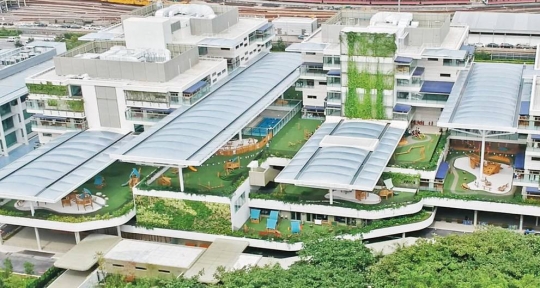One of the main challenges for many expat families is finding the best education for their children. What are the best options academically? And is that option affordable?In previous articles we’ve focused on providing extensive lists of options across the city of Singapore. In this feature, we focus on the Early Learning Village, an establishment that has garnered a lot of attention, and is one of the more intriguing options available for expat families in Singapore, as well as being the first of its kind.
What is the Early Learning Village?
At 50,000 square meters, the Early Learning Village (designed by award-winning Bogle Architects) is the world’s largest pre-school. It is an amalgamation of the Australian International School (AIS) and the Stamford American School. Although both schools are in this building, they operate independently, each offering their own, separate curriculums separate. AIS works from January to December and follows the Australian curriculum, whereas Stamford runs from August to June, operating on the US curriculum.
The concept of the school is aimed at students from the ages of 18 months to six years old. It spreads across five buildings, housing more than 10 classrooms. The pre-school establishment has capacity for 2,100 children, with children in the same year located on each floor accordingly. Both schools have been inspired by the world-famous Reggio Emilia philosophy, which is a popular education option in Singapore.
At first glance, it may seem a bit unusual to have two completely different schools housed so closely, but it makes sense when you realise that they both come under the same parent company – prominent private schooling company Cognita. In fact, the CEO of Cognita said that “two heads are better than one”. From Cognita’s point of view, combining two of their educational centres creates a larger budget which has allowed them to create a space that is considered revolutionary in the early learning sector.
“Research clearly shows that investment in early years doesn’t just give children the best start to their education, it gives them the best start for life. It’s also at the heart of Cognita’s ground breaking Early Learning Village in Singapore. With its innovative design and scale, the Early Learning Village is a timely addition to international school provision on the island.” Sir Kevan Collins, Chairman of Cognita’s Education Advisory Board.
Creating this kind of super building seems a promising solution to the scarcity of available space that Singapore is experiencing, where as many as 82 percent of local people live in high-rise blocks. However, is it a good choice for expat children?
What does the Early Learning Village have to offer?
A possible concern when considering the size of the complex is that children may feel overwhelmed, or that they may not receive the additional support and attention they need. To combat this, classrooms are designed in clusters to avoid overcrowding and to retain a comfortable, cosy environment for the children.
The building is equipped with a plethora of modern amenities and facilities, from state of the art, multi-functional outdoor play decks on several levels, to a 20-meter swimming pool with lanes for beginners, intermediate and advanced swimmers. There’s a specifically built area for gymnastics and dance classes that includes timber floors and child height ballet barres.
Other activities and sports that children can participate in include soccer, tennis, drama and even circus skills!
The Early Learning Village is open for both expat and Singaporean children, meaning your children will still get the chance to integrate socially into Singapore life.
According to the website, the focus at the Early Learning Village is a holistic approach to education. They aim to provide a combination of a stimulating curriculum along with “extensive enrichment opportunities”.
The Village also offers flexible daily and weekly options, allowing you to choose the days and times that your child can attend, rather than set hours to be applied to all students, including half days or extended days for early learners.
They have an optional breakfast club, where professional chefs create a balanced, healthy menu that caters to the requirements and tastes of young children. The children are also supervised for some playgroup activities until the start of the school day. There are also family-style meals available during the day and an afternoon tea club that runs until 6pm.
Two of the world’s most widely spoken languages (Mandarin and Spanish), are offered from the age of 18 months, on a daily basis. There is also a bilingual English/Mandarin programme available from the age of three and onwards.
New technology and teaching techniques such as STEAMInn (Science, Technology,Engineering, Arts, Mathematics and Innovation) activities are implemented in the children’s everyday lives. Through the use of virtual reality and tools such as Bee-Bots, your children can be taught the beginnings of amazing new skills such as problem solving and even the concepts of coding with specially designed toys.
The Early Learning Village was the first school in Singapore to introduce the world-renowned Suzuki Violin lessons to their music programme, which are offered to children from age of three years old. Students can also learn the cello, piano or drums in tailored one-to-one lessons.
The Early Learning Village regularly runs open days where you can go along and see the campus and what’s on offer for yourself, which you can find out more about from either of the school’s websites: Stamford or AIS.
We hope that this guide on Singapore’s Early Learning Village has given you an insight into this interesting new educational centre and given you enough helpful information to consider whether it could be the right option for you and your family. You can read some of our other articles and advice on education and childcare in Singapore here and here.
Do also join our Facebook community to meet and speak to other parents and prospective expat families to share advice, tips, and experience on education and other aspects of life in Singapore.

